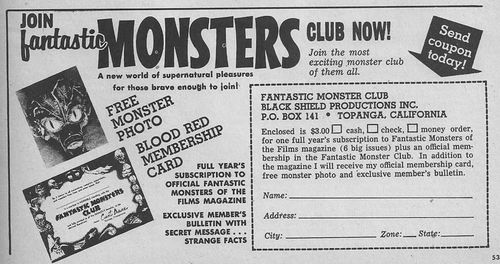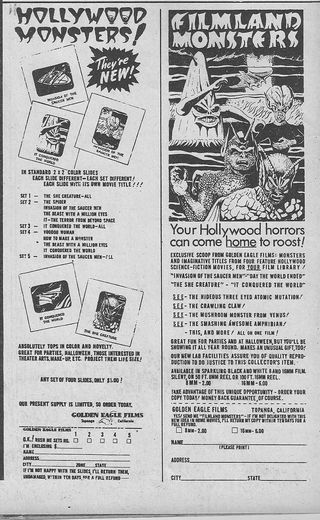
In the pre-flea market, pre-yardsale and pre Ebay days of my youth, a truly exciting place to visit and spend my meager allowance was the Farmer's Market. In concept it seemed to exist somewhere between a wholesale produce market and antique barn. One cubicle was always immediately searched out and perused by me. This area contained a variety of notions (such as rubber monster masks, whoopie cushions, kazoos, etc) and back issues of comics and monster magazines. These periodicals always seemed to be in pretty good condition, except for the tops of the front covers. These were savagely removed, probably by something like a box cutter. I was informed later that this was done so the individual dealer, at the time, could return these sliced off sections of the front covers for credit. The rest of the magazines were subsequently sold to vendors, by weight. Then these vendors, who occupied these cubicles in the Farmer's Markets, would in turn re-sell them, usually for the affordable price of 5 cents per copy. This was definitely within my pre-teen budget.
Perusing the monster magazines I first set my eyes on Fantastic Monsters of the Screen. Having regularly purchased copies of FM and CofF for some time before and since, these seemed almost as interesting. For the grand total of 25 cents I bought the first five (of seven total) issues. This was after carefully perusing all of the available copies. All had that cut across the top, with the titles removed, as well as corresponding portions of several pages beneath. The person who wielded the mutilating box cutter was probably in a hurry. For a nickel apiece, I wasn't planning to save these as collectibles but, rather, to further mutilate them. As did many monster magazine readers of the era, my plans for these issues was to remove the illos of the monsters. These, in turn, would either go into some sort of personal album or decorate the walls of my bed room. I wasn't planning to use anything like a box cutter, though.
As was the case in the other monster mags I acquired, the ads towards the back of the issue were of interest. These were pages filled with the usual 'cool stuff' which went beyond what the vendor in the Farmer's Market had for sale. Two small ads were unique. One was for sets of color slides of 'Hollywood Monsters' and the other was for a 50 foot reel of 8mm film and 100 foot reel of 16mm film of 'Filmland Monsters.' Both ads were illustrated with familiar monsters. The ad copy read: See the Hideous Three Eyed Atomic Mutation, the She Creature, the Crawling Claw, the Smashing Awesome Amphibian…and, the Mushroom Monster from Venus! The illos of the slides matched the subjects of the film footage. Both ads had the same address: Golden Eagle Films of Topanga, California. Of all of the items offered for sale in any of the monster magazines I had ever possessed, these interested me most.
 However, since it was a year or two past the publication dates of Fantastic Monsters (which appeared between 1962-63) I thought the magazine had stopped publishing, and the company – Golden Eagle Films – had long since gone out of existence, along with all of these precious items.. That was that, I surmised.
However, since it was a year or two past the publication dates of Fantastic Monsters (which appeared between 1962-63) I thought the magazine had stopped publishing, and the company – Golden Eagle Films – had long since gone out of existence, along with all of these precious items.. That was that, I surmised.
A friend, and fellow collector, years later lamented that I should have at least dropped a note to Golden Eagle Films at the Topanga Canyon address and inquired if any of the advertised treasures were still available. Thinking back, I figured what a totally logical and terrific idea. It would have been a 50/50 chance. Paul Blaisdell, editor of Fantastic Magazine and seller of the desired items, still lived in Topanga Canyon. He died there in 1983 at the 'youthful' age of 55.
In the few brief, but pleasant, conversations I had with collector Bob Burns, he told me that along with being an accomplished illustrator, sculptor and model maker, Paul Blaisdel was also an accomplished photographer. He often made photographic records during the planning, constructing and usage of his monstrous creations. His medium included color slides and film, 16mm film and stereoscopic photos. American International allowed him to market any and all color slides that he personally took of his 'creations' as well as a limited amount of the film footage that was used in their feature productions. The limitation was that footage of the creatures could be included as long as the featured players were not. This is what comprised the 5 sets of slides as well as what was featured in the 50ft and 100ft of 8mm & 16mm film – in 'sparkling black and white.'
Had I managed to track down these mail order items they would truly be valued collectibles.
All that would be needed next to create the ultimate collectible package would have been the Fantastic Monsters Club package. This consisted of a 'blood red membership card,' a free monster photo (of a Blaisdell creature, natch), an exclusive member's bulletin complete with a secret message and strange facts, plus a year's subscription to Fantastic Monsters. All this for $3! Including the 5 sets of monster slides @ $1 apiece and the 8mm film @ $2–I would also have had to acquire the 16mm film @ $6–this monsterkid would have had to shell out a grand total of $16 (not counting postage) at the time.
The value of all of this in today's collectibles market? Who knows?
